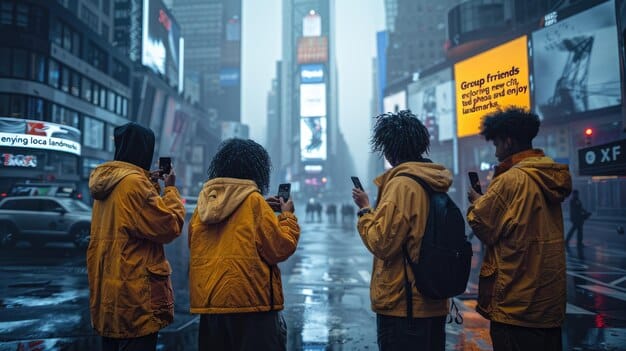Digital Activism in the US: Social Media’s Political Impact

Digital activism in the United States, rapidly evolving through social media, has fundamentally reshaped political discourse, enabling unprecedented speeds of information dissemination and collective action mobilization, influencing policy and public opinion in profound ways.
In an increasingly interconnected world, the ways citizens engage with political processes are constantly evolving. The United States, a nation historically rich in civic participation, has witnessed a profound transformation in its political landscape due to the pervasive influence of digital platforms. This phenomenon, succinctly termed the rise of digital activism in the US: how social media is shaping political discourse, represents a seismic shift from traditional forms of advocacy, ushering in an era where a tweet can ignite a movement and a hashtag can rally thousands.
The Genesis of Digital Activism: From Forums to Feeds
The journey of digital activism is not a sudden emergence but a gradual evolution, mirroring the trajectory of internet technology itself. Initially, online political engagement was limited to rudimentary forums and email chains, serving as niche platforms for like-minded individuals to connect and share ideas. These early iterations, while clunky by today’s standards, laid the foundational bricks for what would become a complex and multifaceted ecosystem of digital advocacy. It was a time when the internet was still largely a novelty, and its potential as a tool for mass mobilization was only dimly perceived.
The advent of Web 2.0 and the subsequent explosion of social media platforms marked a pivotal turning point. Suddenly, communication became bidirectional, interactive, and instantaneously viral. Facebook, Twitter, and later Instagram and TikTok, transformed from mere social networking sites into powerful conduits for political expression and organization. This shift democratized access to information and provided ordinary citizens with a megaphone previously reserved for media conglomerates and political elites.
Early Milestones in Digital Mobilization
Before social media became ubiquitous, some early digital campaigns offered glimpses into its future potential. These efforts, often grassroots and driven by passionate individuals, demonstrated that online connectivity could translate into real-world impact.
- Howard Dean’s 2004 Presidential Campaign: Pioneered online fundraising and community building, showing the power of the internet to circumvent traditional political machinery.
- MoveOn.org’s Rapid Response: Utilized email lists and online petitions to orchestrate swift advocacy campaigns against government policies.
- Online Petitions and Forums: Served as nascent platforms for collective expression, allowing individuals to sign petitions and discuss political topics outside mainstream media.
These initial successes, though modest in scale compared to contemporary movements, proved that digital tools could effectively lower the barriers to political participation. They fostered a sense of collective identity among online communities, turning passive citizens into active participants in the political dialogue. This period was crucial in demonstrating that the internet was not just for commerce or entertainment, but a viable space for civic engagement and dissent.
The progression moved quickly from simple online communities to sophisticated networks capable of coordinating large-scale events and influencing public opinion. The ability to disseminate information without traditional gatekeepers meant that alternative narratives could gain traction, challenging established media portrayals and government messages. This fluidity and speed began to reshape how political messages were crafted, consumed, and acted upon, setting the stage for the powerful role that social media now plays in American political discourse.
Social Media as a Crucible for Political Discourse
Social media platforms have undeniably become central arenas for political discourse in the US, morphing into dynamic, often chaotic, public squares. Unlike traditional media, where information flows largely from a few sources to many, social media operates on a many-to-many model, allowing for decentralized and rapid information exchange. This immediacy means news breaks on Twitter, policy debates unfold on Facebook, and viral political content spreads across TikTok, often before traditional news outlets can even verify it.
The nature of this discourse is distinct. It’s often characterized by rapid-fire reactions, memes, and short-form content that prioritizes virality and emotional resonance over nuanced discussion. While this fosters broad participation and a sense of direct engagement, it also presents significant challenges. The algorithms designed to maximize engagement can create echo chambers, reinforcing existing beliefs and limiting exposure to diverse perspectives. This can lead to increased political polarization, where individuals inhabit digital spaces primarily populated by those who share their exact views, making genuine dialogue and compromise more difficult.
The Dual Edges of Digital Democracy
The expansive reach of social media offers unparalleled opportunities for marginalized voices to be heard and for grassroots movements to gain rapid momentum. Communities that traditionally lacked access to mainstream media platforms can now self-organize, share their experiences, and demand attention for their causes. This democratizing effect allows for a broader spectrum of political issues to enter public consciousness.
- Amplification of Marginalized Voices: Social media provides platforms for underrepresented groups to share their narratives and organize, bypassing traditional media gatekeepers.
- Rapid Dissemination of Information: News and political updates can spread globally in seconds, often providing immediate, unfiltered accounts of events.
- Direct Citizen Engagement: Politicians and advocacy groups can directly interact with constituents and supporters, fostering a sense of accessibility and responsiveness.
However, this very openness also renders these platforms vulnerable to manipulation. The spread of misinformation and disinformation, often amplified by foreign actors or partisan groups, poses a significant threat to informed public discourse. Bots and coordinated influence campaigns can distort public perception, fueling distrust and division. The lack of traditional editorial oversight means that the responsibility for fact-checking largely falls on individual users, who may not possess the necessary tools or inclination for critical evaluation.
Furthermore, the ephemeral nature of online debates can lead to superficial engagement with complex issues. Soundbites and viral clips often replace deep dives into policy, potentially simplifying critical public debates to a dangerous degree. While social media has undeniably created a more inclusive and immediate political conversation, its mechanisms also necessitate a discerning approach from both users and regulators to preserve the integrity of democratic discourse.

Mobilization and Collective Action in the Digital Age
One of the most striking impacts of social media on US political discourse is its unparalleled capacity for mobilization and collective action. Gone are the days when organizing a large-scale protest required weeks of logistical planning, flyer distribution, and phone trees. Today, a single viral post or a trending hashtag can rapidly assemble thousands, or even millions, of individuals around a common cause, transforming online sentiment into tangible real-world action.
This agility allows movements to emerge and adapt with unprecedented speed, responding almost instantaneously to unfolding events. From swift public reactions to legislative decisions to immediate calls for solidarity in moments of crisis, social media acts as a central nervous system for collective engagement. It enables individuals who might otherwise feel isolated to discover a shared grievance or passion, fostering a sense of community and empowering them to act collectively.
Case Studies in Digital Mobilization
Numerous movements in recent years owe much of their rapid growth and widespread impact to the strategic utilization of social media. These examples illustrate how digital platforms can bridge the gap between online advocacy and offline action.
- Black Lives Matter: Initially emerging from a hashtag, BLM quickly evolved into a global movement, with social media serving as its primary tool for organizing protests, disseminating information, and challenging dominant narratives.
- March for Our Lives: Gained massive momentum online, culminating in one of the largest student-led protests in US history, demonstrating effective coordination via digital channels.
- Me Too Movement: Empowered survivors to share their stories and collectively demand accountability, creating a powerful, interconnected online space that transcended geographical boundaries.
These movements leveraged social media not just for awareness, but for intricate coordination: announcing protest locations and times, sharing safety protocols, live-streaming events, and amplifying diverse voices. The ability to share user-generated content, such as videos and photographs from demonstrations, further enhances the visibility and emotional impact of these movements, often reaching audiences that traditional media might overlook or misrepresent.
However, the ease of digital mobilization also poses challenges. The “slacktivism” critique suggests that online actions, like signing a petition or sharing a post, might sometimes substitute for deeper, more demanding forms of engagement. While social media can initiate collective action, sustaining it over the long term often requires more traditional forms of organizing and commitment. Nevertheless, the power of these platforms to ignite and coordinate large-scale collective action remains a defining feature of contemporary US political activism, altering the mechanics of protest and advocacy.
Challenges and Criticisms of Social Media Activism
While social media has undeniably revolutionized political discourse and mobilization, it is not without its significant challenges and criticisms. The very features that make it powerful also create vulnerabilities and present obstacles to effective, sustainable activism. One prominent concern is the issue of misinformation and disinformation. The speed and virality of social media content mean that false narratives can spread rapidly and widely, often before fact-checkers can intervene. This can sow confusion, erode trust in legitimate sources, and even incite real-world harm. The algorithms, optimized for engagement, often inadvertently prioritize sensational or emotionally charged content, regardless of its factual accuracy, exacerbating the problem.
Another major critique revolves around the concept of “slacktivism” or “clicktivism.” This argument suggests that engaging in low-effort online actions, such as signing an online petition or sharing a post, may provide a false sense of accomplishment without contributing to meaningful, sustained change. While such actions can certainly raise awareness, critics fear they may sometimes deter individuals from participating in more demanding forms of activism, like attending protests, volunteering, or making financial contributions. The ease of online engagement can, paradoxically, reduce the depth of commitment required for truly impactful social change.
Navigating the Digital Minefield
The digital landscape is also fraught with issues of privacy and surveillance. Activists using social media platforms may inadvertently expose themselves to scrutiny from state actors, law enforcement, or malicious groups. Data collection practices by tech companies, even if ostensibly for commercial purposes, can have unintended consequences for those attempting to organize and exercise their rights to free speech. The potential for doxing, harassment, and other forms of online abuse further complicates the digital activist’s environment, often leading to self-censorship or withdrawal.
- Echo Chambers and Polarization: Algorithms can create filter bubbles, isolating users within like-minded communities and limiting exposure to diverse viewpoints, thereby deepening political divides.
- Misinformation and Disinformation: The rapid spread of false or misleading information poses a significant threat to informed public discourse and can undermine trust in institutions.
- Online Harassment and Doxing: Activists, particularly those from marginalized communities, face increased risks of harassment, threats, and exposure of personal information, which can chill free expression.
Furthermore, the ephemeral nature of online attention spans means that movements sometimes struggle to maintain momentum after an initial burst of viral activity. The “outrage cycle” can lead to rapid shifts in focus, making it difficult for sustained campaigns to gain traction. Issues can quickly capture public attention only to be superseded by the next trending topic, diluting long-term impact. Addressing these challenges requires not only responsible platform governance but also a critical approach from users, an understanding of digital literacy, and a commitment to balancing online visibility with offline, strategic action to truly influence policy and foster meaningful change.
The Impact on Traditional Political Processes
The ascendancy of digital activism and social media has not merely created a new avenue for political discourse; it has fundamentally reshaped traditional political processes in the United States. From election campaigns to policymaking, and from constituent relations to media engagement, virtually every aspect of the political establishment has been forced to adapt to the realities of a digitally connected populace. Political campaigns, once reliant on door-knocking, rallies, and television ads, now allocate significant resources to digital strategists, social media managers, and online fundraising. Candidates and parties use platforms like Twitter and Facebook to deliver real-time messages, respond to opponents, and gauge public sentiment instantly.
This immediate feedback loop means that political actors can no longer afford to be disconnected from the online conversation. Public opinion, often expressed vociferously on social media, can quickly influence legislative agendas, forcing issues onto the political main stage or compelling elected officials to respond to pressing concerns. Lawmakers now use their social media presence not just to broadcast, but to engage, inviting questions from constituents, participating in online town halls, and attempting to sway public opinion directly. This direct line of communication bypasses traditional media filters, allowing politicians to craft their own narratives, though it also opens them up to immediate scrutiny and viral criticism.
Moreover, social media has profoundly altered the relationship between politicians and the media. News cycles are now often driven by viral social media moments, forcing traditional news outlets to monitor digital platforms constantly for breaking stories, statements, and trends. Political gaffes or policy pronouncements made on social media can instantly become national headlines, sometimes with little room for the kind of careful analysis once afforded by a slower news cycle. This acceleration of information flow places immense pressure on both politicians to be constantly “on” and on journalists to rapidly verify and contextualize information.
The overall effect is a political environment that is faster, more reactive, and often more fragmented. While it offers unprecedented opportunities for transparency and direct engagement, it also demands constant vigilance against misinformation and manipulation. The challenge for traditional political processes is to harness the democratic potential of social media while mitigating its risks, ensuring that speed does not compromise depth, and that increased participation translates into genuinely informed and productive discourse rather than mere online noise.
The Future Landscape of Digital Activism
As technology continues its relentless march forward, so too will the landscape of digital activism in the United States. Predicting the exact trajectory is challenging, but several emerging trends and technologies are poised to shape its future. Artificial intelligence (AI) and machine learning, for instance, are already beginning to play a role, from sophisticated data analysis for campaign targeting to personalized content delivery. While these tools can enhance efficiency and reach for activists, they also raise ethical questions about manipulation, surveillance, and the potential for deepfakes to further complicate the truth. The rise of virtual and augmented reality (VR/AR) could create entirely new immersive spaces for political engagement, offering novel ways to experience protests, debates, or even simulated policy outcomes, potentially fostering deeper empathy or understanding.
The decentralization afforded by blockchain technology could also find applications in digital activism, offering secure, transparent, and immutable records of petitions, votes, or crowd-sourced funding. Such advancements might circumvent censorship or enhance the integrity of online organizational efforts. Furthermore, we can expect a continued evolution in the platforms themselves, with new social media apps constantly emerging, each with unique features that might resonate differently with various demographics and types of activism. The shift towards more visual, interactive formats, and perhaps away from purely text-based communication, could also influence how political messages are crafted and consumed.
Emerging Trends and Potential Impacts
The future of digital activism will likely be characterized by increasing sophistication and a continued blurring of lines between the online and offline worlds. As digital literacy becomes more widespread, and as younger generations, entirely native to these technologies, assume greater civic roles, the forms of protest and advocacy will undoubtedly become more innovative and integrated with digital tools.
- Hyper-Personalized Mobilization: AI and data analytics will allow activists to connect with individuals based on highly specific interests and demographics, leading to more tailored messaging.
- Increased Regulatory Scrutiny: Governments and platforms will likely face growing pressure to address issues like misinformation, foreign interference, and online hate speech, potentially leading to new policies or content moderation practices.
- Decentralized Autonomous Organizations (DAOs): Blockchain-based DAOs could offer new models for activist groups, enabling transparent, democratic decision-making and resource allocation.
However, alongside these advancements, the challenges will also intensify. The battle against misinformation will likely become more complex as AI-generated content becomes indistinguishable from reality. Issues of digital divide, ensuring equitable access to these powerful tools, will remain critical. Furthermore, the constant negotiation between free speech and content moderation will demand careful consideration. The future of digital activism will require not only technological innovation but also a robust public discourse on ethics, digital rights, and the responsible use of powerful new tools to ensure that these advancements work towards strengthening, rather than undermining, democratic processes and the informed political involvement of citizens.
Ethical Considerations and Responsible Digital Citizenship
The power of social media to galvanize movements and shape discourse comes with a significant ethical imperative. For digital activism to be truly beneficial and sustainable, participants must grapple with a range of ethical considerations and cultivate responsible digital citizenship. One primary concern is the spread of misinformation and disinformation. While platforms bear a responsibility to combat this, individual users also have a crucial role to play. Verifying sources, cross-referencing information, and resisting the urge to share unverified content are fundamental tenets of responsible digital engagement. The viral nature of social media means that even unintentional sharing of false information can have widespread negative consequences, eroding public trust and undermining legitimate causes.
Another crucial ethical dimension lies in the area of online conduct and civility. The anonymity afforded by the internet can sometimes lead to disinhibition, fostering environments where harassment, doxing, and aggressive rhetoric become commonplace. Responsible digital citizenship demands adherence to principles of respect, empathy, and constructive dialogue, even when engaging with opposing viewpoints. The goal of activism should be to persuade, educate, and mobilize, not to silence or intimidate. Cultivating a digital space where respectful disagreement is possible is essential for fostering healthy political discourse, rather than simply exacerbating existing divides.
Building a Healthier Digital Ecosystem
Beyond individual conduct, there are broader ethical considerations regarding the impact of digital activism on mental health, privacy, and social cohesion. Constant exposure to emotionally charged content and the pressure to perform “activism” online can contribute to burnout and anxiety. Furthermore, the extensive data collection by social media companies raises concerns about surveillance and the commercialization of political engagement, as user data can be leveraged for targeted advertising or even political manipulation.
- Fact-Checking and Source Verification: Actively questioning and verifying information before sharing is crucial to combating the spread of misinformation.
- Cultivating Empathy and Civility: Engaging in respectful dialogue, even with differing opinions, is vital for constructive discourse and reducing online toxicity.
- Protecting Data Privacy: Understanding how personal data is collected and used by platforms, and advocating for stronger privacy protections, safeguards against misuse.
Ultimately, fostering a more responsible digital ecosystem requires a collective effort. It involves platforms implementing clearer content moderation policies and prioritizing user well-being, educators teaching critical digital literacy skills, and individuals actively practicing ethical online behavior. Digital activism, at its core, seeks to bring about positive change. To achieve this, it must operate on a foundation of truth, respect, and a deep understanding of its own ethical responsibilities. Only then can it truly fulfill its potential as a force for good in shaping political discourse and democratic participation.
| Key Aspect | Brief Description |
|---|---|
| 📲 Digital Mobilization | Social media rapidly coordinates large-scale collective actions and protests. |
| 🗣️ Shaped Discourse | Platforms define how political news spreads, affecting public opinion and debate. |
| ⚠️ Key Challenges | Misinformation, polarization, and “slacktivism” pose significant hurdles. |
| 🔮 Future Trajectory | AI, VR, and blockchain will likely further transform digital activism. |

Frequently Asked Questions About Digital Activism
Digital activism refers to the use of internet-based platforms and digital technologies to facilitate social and political change. This includes online petitions, social media campaigns, fundraising, and the dissemination of information to mobilize collective action and influence public opinion or policy decisions.
Social media has significantly democratized political discourse in the US by allowing direct, immediate communication between citizens and politicians. It has amplified marginalized voices, enabled rapid information sharing, and facilitated large-scale mobilization, but also contributed to polarization and the spread of misinformation.
Key criticisms include the rise of “slacktivism” (low-effort online engagement), the spread of misinformation and disinformation, the creation of echo chambers that deepen polarization, and concerns over online harassment and privacy issues due to extensive data collection by platforms.
Yes, digital activism can undeniably lead to real-world change. While some online actions might be superficial, highly successful movements like Black Lives Matter and March for Our Lives demonstrate social media’s power to organize protests, raise awareness, and pressure policymakers, translating online engagement into tangible societal impact.
The future of digital activism will likely involve greater integration of AI for targeted messaging and analysis, potential uses of VR/AR for immersive engagement, and blockchain for transparency. There will also be increased scrutiny on platform regulation and the ongoing challenge of combating sophisticated forms of misinformation.
Conclusion and the Evolving Digital Frontier
The journey of digital activism in the United States, from nascent online forums to its current ubiquitous presence across social media platforms, represents a profound and ongoing transformation of political discourse. It has redefined how citizens engage with power, how movements are born and nurtured, and how information—and misinformation—permeate the public sphere. Social media has undeniably democratized access to political participation, amplifying voices that were once unheard and enabling swift, large-scale collective action. Yet, this power comes with inherent complexities, including the proliferation of false narratives, the deepening of political polarization, and the persistent challenge of distinguishing superficial online engagement from meaningful, sustained change.
As we look ahead, the digital frontier of activism is poised for continued evolution, shaped by emerging technologies such as artificial intelligence, virtual reality, and blockchain. These innovations will likely bring unprecedented levels of personalization, immersion, and transparency to digital campaigns, offering new tools for mobilization and advocacy. However, they also demand a renewed focus on ethical considerations, digital literacy, and responsible citizenship. The ongoing balance between freedom of expression and the need for content moderation, alongside the critical imperative to verify information and foster constructive dialogue, will determine whether digital activism truly strengthens or inadvertently undermines the democratic processes it seeks to influence. The narrative of digital activism is still being written, and its ultimate impact will depend on the collective commitment of individuals, platforms, and policymakers to harness its potential responsibly while mitigating its significant risks.





